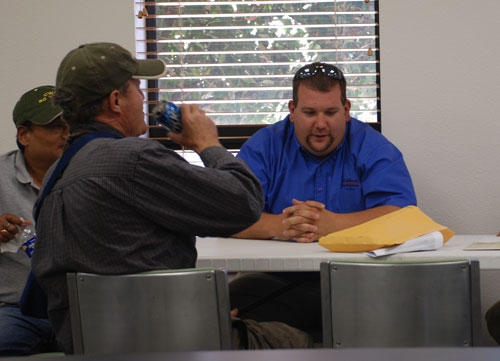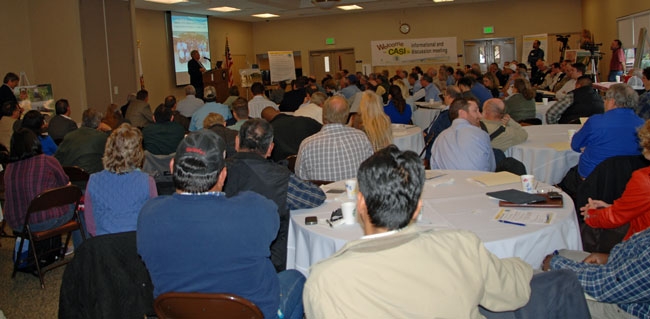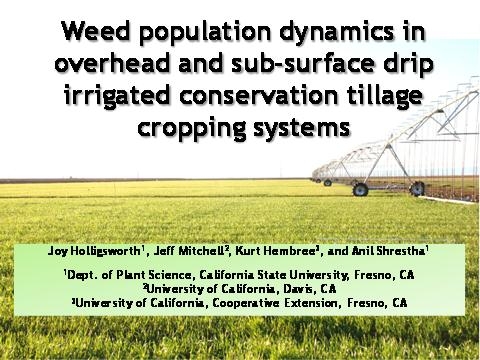Conservation agriculture news
Rain-fed winter cover crops offer multiple benefits at low cost
Even on the west side of the San Joaquin Valley, where average rainfall is a mere 7 inches per year, farmers can reap the benefits of winter cover crops without the expense of irrigation, University of California research has found. Growing a winter cover crop helps retain soil nitrogen – keeping it from leaching into groundwater – improves water infiltration, reduces runoff, increases soil organic matter and boosts long-term soil fertility.
Moreover, a vigorously growing cover crop can smother winter weeds, reducing or eliminating the need for herbicides or tillage between crops.
“Despite the many and varied benefits of cover cropping that are increasingly seen by farmers in other parts of the country, the vast majority of Central Valley farmers currently do not use them,” said Jeff Mitchell, UC Cooperative Extension specialist in the Department of Plant Sciences at UC Davis. Mitchell, a cropping systems expert, is based at the Kearney Agricultural Research and Extension Center in Parlier, Calif.
The costs and benefits of winter cover crops are being examined in an ongoing trial at the UC West Side Research and Extension Center in Five Points, Calif. Initiated in 2000, the trial is led by Mitchell, William Horwath, a professor in the Department of Land, Air and Water Resources at UC Davis, and Dan Munk, UC Cooperative Extension advisor in Fresno County, a cotton and soils expert.
Mitchell said the West Side trial addresses valley farmers’ primary concern about cover crops – water.
“When water is short, as it has been in many recent years, farmers wonder how inserting an extra crop that doesn’t bring an immediate return on investment makes sense,” Mitchell said. “But our work over the last 12 years has demonstrated that cover cropping ‘on the cheap’ – relying only on rainfall for irrigation – supplies many benefits and doesn’t cost much.”
Rainfall during the November to March winter growth period in Five Points averages 7 inches, slightly less than the 30-year average annual rainfall of 7.6 inches for the site. Winter rainfall has varied considerably during the trial, from a low of 2.9 inches in 2003 to a high of 11 inches in 2006.
From 2000 to 2010, a cover crop mix of triticale, ryegrain and pea was grown at a seed cost of $55 per acre (2012 dollars). In 2011 and 2012, the researchers used a mixture of fava bean and “tillage radish” for the cover crop, at a cost of $50 per acre.
Tillage radish is a large-rooted winter annual being marketed for its ability to improve soil condition. It’s thick, tuberous roots break up the soil surface. When it is killed in the spring and the roots decompose and shrivel, it leaves behind channels that help with aeration and water infiltration.
Over the course of the UC trial, an average of 3,400 pounds of dry biomass per acre was produced by the cover crops each year with rainfall alone. Productivity generally related to the amount of rain, with as little as 65 pounds of dry biomass per acre in 2007, when rainfall was 5.2 inches, and 6,400 pounds in 2005, when 10.1 inches of rain fell.
The timing of rainfall was also important. Rain is needed early to establish the crop and late in the season to sustain its growth when the temperature warms.
Over time, growing cover crops results in a significantly higher amount of carbon in the top foot of soil. Following eight years of cover cropping, soil carbon values in the standard tillage cover crop system, in which the cover crop was treated as a green manure and incorporated into the soil at a depth of 10 inches, was 12.2 tons of carbon per acre. Where cover crops were combined with conservation tillage, the researchers measured 12.8 tons per acre. In areas managed with conservation tillage and no cover crop, 11.7 tons per acre of carbon was in the top foot of soil. Under standard tillage and no cover crops, currently the common practice in the San Joaquin Valley, soil carbon came in at 9.9 tons per acre.
In addition to improving soil quality, farmers are investigating whether storing extra carbon in the soil will make them eligible for selling carbon credits under California Assembly Bill 32, the Global Warming Solutions Act.
“Sequestering carbon in farmland could be a means of mitigating global warming from greenhouse gas emissions,” Mitchell said. “We are working with farmers to develop a record of performance so they can document their potential for storing more carbon using conservation tillage and cover crops.”
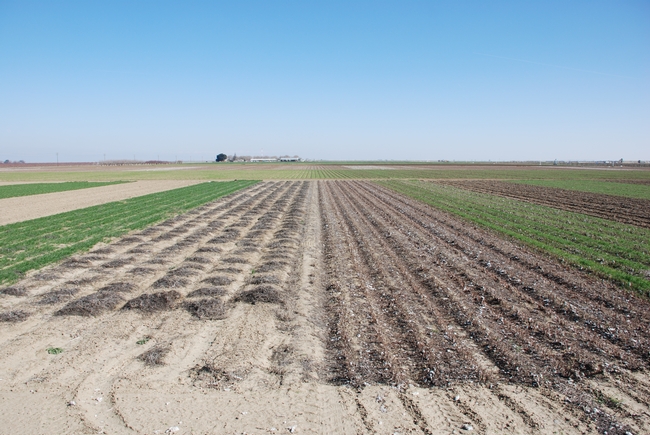
Experimental field in which conservation tillage with and without cover crops are being compared to standard tillage systems.
Local conservation ag expert featured in No-Till Farmer magazine
A longstanding member of the UC Conservation Agriculture Systems Initiative, Monte Bottens, is featured with his father in the March 2012 issue of No-Till Farmer magazine.
Monte and Bob Bottens are a father-son no-till team in Cambridge, Ill. The article outlines their 16-year effort to grow corn and soybeans using conservation agriculture practices. The Bottens were honored with this year’s ‘Responsible Nutrient Management Practitioner’ Award at the 2012 National No-till Farmer Conference in St. Louis, Mo.
Bottens is currently a part of CASI's Executive Group.
Another article in the same issue of No-Till Farmer presents a provocative and intriguing business model that recognizes the long-term value of high-quality soils, said Jeff Mitchell, UC Cooperative Extension cropping systems specialist. A group of farmers and investors launched Fall Line Farms at the 2012 annual National No-till Farmer Conference held in February in St. Louis, Mo.
Fall Line Farms seeks to expand no-till systems and increase awareness of the value of soil quality. The new company is offering to become capital partners for no-tillers who don't have the resources to buy farmland. It will consider prospects in any geographical area in the U.S. and may also offer advice on equipment, technology and agronomy to lessees.
One of the company's founders, Clay Mitchellis, is a 38-year-old farmer in northeast Iowa and holds a degree in biomedical engineering from Harvard University. He is known worldwide for his innovative farming systems and cutting edge agricultural practices and technologies.
The articles in PDF format are linked below.
New company aims to help no-tiller expand (PDF)
Father-son team aims to thrive, not survive (PDF)
Looking ahead to conservation agriculture success
The UC Conservation Agriculture Systems Initiative challenges Californians to look 100 years, or even 500 years, into the future and imagine how today’s common agricultural practices will have impacted the environment and society.
The United Nations estimates world population in 2300 will be about 9 billion. There is likely to be significant development in the ensuing 300 years that reduces the amount of land for farming.
“We have to be able to do more with less,” said Jeff Mitchell, UC Cooperative Extension cropping systems specialist, echoing a common theme repeated by speakers at the launch of the UC Conservation Agriculture Systems Initiative (CASI) Jan. 27. “The global demand for food will be immense.”
An overflow crowd of 125 farmers, equipment providers, public agency representatives and long-time conservation agriculture supporters participated in the launch. The meeting provided information about the evolution of the Institute, its recent research and development work on conservation agriculture systems, and its new capacity-building initiatives to increase the adoption of competitive and sustainable production systems in California’s San Joaquin Valley.
Mitchell, other researchers and many innovative farmers have documented in more than 14 years of field research that changes in traditional farming practices – employing such technologies as precision irrigation, integrated pest management and conservation tillage – cut costs $75 to $150 per acre, reduce dust and diesel fuel emissions 60 to 80 percent, and prevent evaporation of about 4 inches of water per season from the soil surface.
This sort of objective data, plus favorable economic analyses and access to high-technology conservation equipment, are important factors in motivating farmers to change their practices, but they are not the only factors, Mitchell said. The Institute is committed to not only demonstrating and communicating the documented benefits of conservation agriculture but also identifying the drivers behind behavior change. The goal is converting 50 percent of California crop acreage to conservation practices by 2028.
“The cornerstone of sustainability is behavior change,” said Ron Harben of the California Association of Resource Conservation Districts, one of the Initiative’s founders. “Simply providing information has little or no effect on what people do.”
In parts of the U.S. and the world, conservation agriculture is common practice. World leaders in conservation agriculture include Brazil, Argentina and Paraguay, Western Australia and Canada. Within the next ten years, Mitchell reported, more than 85 percent of the cropland in the three South American countries is expected to be converted to conservation agriculture. Adoption rates are also quite high in parts of South Dakota, Nebraska, the Pacific Northwest, and areas throughout Alabama and Georgia. Yet implementation in California is still low.
In 2010, conservation tillage systems accounted for about 14 percent of the acreage in silage and grain corn, small grains for hay, silage and grain, tomatoes, cotton, dry beans, and melons in the nine-county Central Valley region. This was an increase from about 10 percent in 2008. Minimum tillage practices were used on about 33 percent of crop acreage in 2010, up from about 21 percent in 2008.
Mitchell said the implementation trends around the world, in the U.S. and in California “lend a certain inevitability” to its wide adoption in the San Joaquin Valley.
“This is not just about making a profit and optimizing yields,” Mitchell said. “By minimizing soil disturbance, preserving surface residue and including a greater diversity of crops in the rotation we are improving the soil resources and deepening the soil in an improved condition.”
The keynote speaker at the CASI launch was Hanford dairy farmer Dino Giacomazzi, a long-time innovator in conservation agriculture. Giacomazzi discovered conservation agriculture not long after taking over day-to-day operations of the Giacomazzi dairy from his father.
“It’s less work for more money,” Giacomazzi said. “Why aren’t people doing it? What’s the holdup?”
Perhaps in answer to his own question, Giacomazzi shared the reaction of his father to the new system being used on their farm. In their last conversation, the elder Giacomazzi lamented that, “Everything I’ve ever done, you’ve undone,” his son related at the meeting.
Dino Giacomazzi said many farmers’ tendency to be “enthralled” with tradition, their fierce independence, aversion to risk and fear of derision from neighbors contribute to their resistance to change. But accepting change is what is needed to adapt to a rapidly changing world.
Giacomazzi said the new Institute will play an important role in supporting farmers as they convert to conservation practices.
“This can’t be just a launch,” Giacomazzi said. “We must make this happen. Stay in touch.”
A video of the complete CASI January 27 launch meeting will soon be available at the Institute’s website http://ucanr.org/CASI.
Student honored for conservation ag research
Congratulations to Joy Hollingsworth, a first-year graduate student working with Dr. Anil Shrestha in the Department of Plant Science at CSU Fresno, for having been awarded the 2012 Student Paper and Poster Contest Award from the California Weed Science Society at their recent annual meeting. Joy’s paper, ‘Weed population dynamics in overhead and sub-surface drip irrigated conservation tillage cropping systems,’ received the Society’s award at their January 23 – 25 meeting in Santa Barbara.
Now, she’s off to Hawaii this week for a poster presentation at the 2012 annual meeting of the Weed Science Society of America in Waikoloa, Hawaii.
Way to go, Joy!
UC launches “Conservation Agriculture Systems Initiative” Jan. 27
A diverse group of public and private sector agricultural professionals are joining the University of California to form the Conservation Agriculture Systems Initiative (CASI), an organization that will be formally launched at a public meeting Jan. 27 in Clovis, Calif.
“This is the agronomic and ecological equivalent of the ‘moon race’ back in the early 1960s,” said CASI coordinator Jeff Mitchell, a UC Cooperative Extension cropping systems specialist.
The Initiative merges two existing University programs – the Conservation Tillage and Cropping Systems Workgroup and the California Overhead Irrigation Alliance – into a single, broad-based initiative. The launch and informational meeting takes place from 10 a.m. to 1 p.m. Friday, Jan. 27, at the Veterans’ Memorial Building, 808 Fourth St., Clovis. (Map)
CASI’s aim is to bring together farmers, business leaders, public agency representatives, university, USDA Natural Resources Conservation Service and environmental group membership to chart long-term goals for sustainable agriculture in the San Joaquin Valley and to develop appropriate conservation agriculture production systems that will achieve these goals.
The term ‘conservation agriculture’ enjoys broad recognition and understanding in other parts of the U.S. and internationally, but it is a relatively new addition to California’s ag lexicon. In general, conservation agriculture aims to achieve profitable and sustainable agricultural systems and improve the livelihoods of farmers while conserving natural resources. These goals are met through the application of general principles that have been widely documented and demonstrated by research and experience as effective features of sustainable production systems.
These principles include:
- Minimum soil disturbance
- Preservation of residues that provide permanent soil cover
- Diverse crop rotations
- Use of cover crops
- Integrated pest management
- Reliance on precision, highly-efficient irrigation
- Controlled or limited mechanical traffic over agricultural soils
Together, these practices, when optimally employed within a given cropping context or environment, provide a basis for long-term sustainability and are gaining acceptance in many parts of the world as an alternative to both conventional and organic agriculture.
Because conservation tillage and other soil conservation practices are the cornerstones of conservation agriculture, there are both challenges as well as opportunities for California systems to be developed in the San Joaquin Valley, a historically tillage-intensive production region. Information on recent research and farmer innovation toward the broad goals of conservation agriculture will be part of the program at the January 27th meeting.
“CASI extends an invitation to all who would like to be a part of this major effort to actively take part with its founders on Jan. 27 and help with the development of improved agricultural production systems for the San Joaquin Valley,” Mitchell said.
Media contact: Jeff Mitchell, (559) 303-9689, Mitchell@uckac.edu
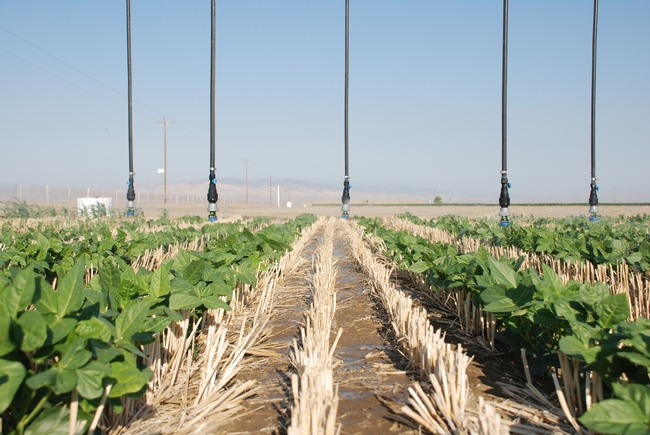
Conservation agriculture is gaining acceptance in many parts of the world as an alternative to both conventional and organic agriculture.

